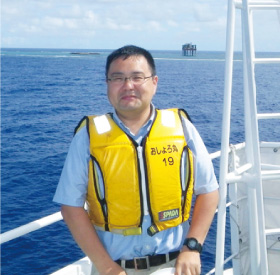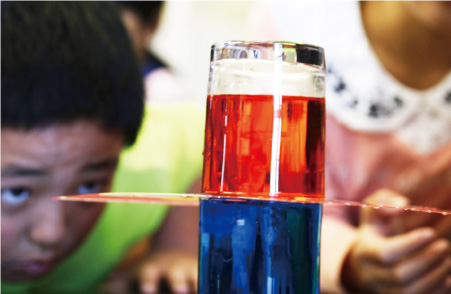- Announcements for middle and high school students
- Information for Middle and High School Researchers
- Information for Teachers
What is education for passing on the richness of the sea to the next generation?
2020.10.08
Center for Marine Education, Graduate School of Education, The University of Tokyo
Yoshihiro Niwa, Project Associate Professor
 The Center for Marine Education, Graduate School of Education, the University of Tokyo, is the center of marine education in Japan. Researchers in marine science and education work together to develop marine education curricula in collaboration with schools, boards of education, and social education facilities throughout Japan, and conduct activities to put them into practice and disseminate them. Specially Appointed Associate Professor Yoshihiro Niwa, a marine physicist, conducts experiential classes, stands in the field of practice, and seeks education for a sustainable future.
The Center for Marine Education, Graduate School of Education, the University of Tokyo, is the center of marine education in Japan. Researchers in marine science and education work together to develop marine education curricula in collaboration with schools, boards of education, and social education facilities throughout Japan, and conduct activities to put them into practice and disseminate them. Specially Appointed Associate Professor Yoshihiro Niwa, a marine physicist, conducts experiential classes, stands in the field of practice, and seeks education for a sustainable future.
Understanding the reality of the three-dimensional thickness of the ocean
Mr. Niwa believes that there are still many issues to be addressed in marine education, which aims to develop human resources who can think and act in harmony with the ocean and humankind. One problem is that the ocean-related content in current textbooks is fragmented and superficial. For example, the Kuroshio and Oyashio currents are taught in fifth grade social studies, but children are taught only the "facts" of the warm and cold currents that flow in the Pacific Ocean, and the specific images they get are vague.
In a class conducted at an elementary school in Kesennuma, Miyagi Prefecture, Niwa asked the children, "Which do you think is richer, the Oyashio or the Kuroshio?" Many of the children responded that the Kuroshio Current was warmer, based on the image of a warmer ocean. Many of the children responded that the Kuroshio Current was warmer, based on its image of warmth. In reality, the Kuroshio Current is a current of surface seawater warmed at low latitudes that flows in a nutrient-poor state without mixing with the deeper layers. On the other hand, in the Oyashio, surface seawater cooled in high latitudes sinks and mixes with the deeper layers, providing rich nutrients from the deeper layers. Mr. Niwa encouraged hands-on understanding of this through an experiment using a glass of colored warm and cold water, and explained the transport of nutrients and the food chain of marine organisms that occurs in the process of water mixing up and down. Through this lesson, the children understood that ocean currents are not just surface currents indicated by arrows in textbooks, but are three-dimensional, changing in the direction of depth, and that there is a cycle of matter and life within them.
One of the difficulties in marine education is that the "ocean," which is represented by the single word "sea," is in fact a vast expanse of water from the surface to the depths and from coastal areas to offshore areas, with various characteristics, most of which we cannot see directly. This is why Mr. Niwa stresses the need to make efforts to convey the reality and mechanisms of the ocean in an easy-to-understand manner by utilizing familiar phenomena and experiments.
I can't live without being involved in the sea.
The goal is to implement marine education in all municipalities. The hurdle to achieving this goal is not only the vastness of the ocean, but also the differences between regions. Children in coastal schools, where the ocean is close at hand, and children in inland schools, far from the ocean, will have a completely different foundation of knowledge and interest from their daily lives. In coastal areas where the ocean is close by," says Mr. Kato, "visiting fishermen and aquariums to learn about the local sea would be a good way to develop an interest in the area. On the other hand, schools in mountainous areas are experimenting with ways to bring the ocean closer to their students, for example, by making prototypes of local dishes that exclude sea ingredients and comparing them," says Niwa.
Mr. Niwa himself was born in Gifu Prefecture, a "sea-less" prefecture. He never had the opportunity to develop a strong interest in the ocean until he graduated from high school, but he became interested in the subject of turbulence while studying physics at university and entered the world of ocean physics. However, it is not the case that children born and raised in inland areas have no connection with the ocean. As the saying goes, "the forest is the lover of the sea," and the nutrients metabolized in the forest ecosystems of mountainous areas flow down rivers and enrich the oceans. In addition, most of the ocean plastic, which has become a global problem in recent years, flows into the ocean from rivers. In addition, much of the carbon dioxide we emit in our daily lives dissolves into seawater, causing ocean acidification. Even if there is no ocean in our living area, we are always involved with the ocean.
Each of us needs to learn, think and act.
In order to develop human resources who can think and act in harmony with the ocean and people, which is the goal of marine education, it is essential to go beyond simply understanding basic knowledge and to think in concrete terms about how each region and society is affected by the ocean and how it affects them. To this end, Mr. Niwa urges the need for a forum where teachers and experts from various regions can share their practices and experiences in marine education and exchange opinions. The challenges of the oceans are spreading before our eyes, and those who teach must learn to pass them on to the next generation. Because Japan is surrounded by oceans and receives more benefits from them than any other country, the preservation of the marine environment and marine resources has a significant impact on the state of the nation. The world's oceans are connected as one, highlighting pressing issues such as global warming, ocean plastic problems, and declining fishery resources. In order to think about the future, Mr. Niwa also said that he hopes that not only children, but also teachers and experts themselves will go back to the beginning and think together about the situation surrounding the oceans.
How can each individual learn basic ocean-related knowledge (literacy), how to think and act in harmony with the ocean, and how to pass this knowledge on to the next generation? In order to spread ocean education throughout Japan, we must continue to learn and exchange ideas with each other, and think about how to create a Japanese-style ocean education.

Teaching a class on "How the Ocean Works" at an elementary school in Kesennuma City, Miyagi Prefecture

An experiment to learn the difference between the Kuroshio and Oyashio Currents. When an underlay between two cups is pulled out, if the upper water is warmer (in the case of the Kuroshio Current), the upper and lower layers are maintained, but if the upper water is colder (in the case of the Oyashio Current), the upper and lower layers mix together.
(Text by Yuzen Kodama)
*Reprinted from "Education Support vol. 46
